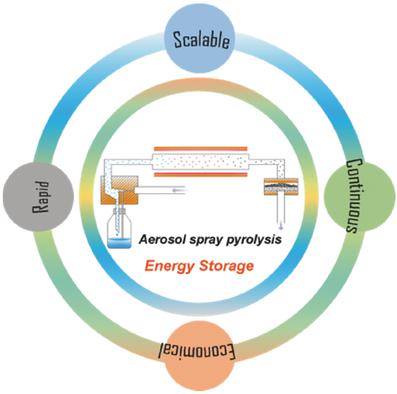当前位置:
X-MOL 学术
›
Small Methods
›
论文详情
Our official English website, www.x-mol.net, welcomes your
feedback! (Note: you will need to create a separate account there.)
Aerosol‐Spray Pyrolysis toward Preparation of Nanostructured Materials for Batteries and Supercapacitors
Small Methods ( IF 10.7 ) Pub Date : 2017-12-05 , DOI: 10.1002/smtd.201700272 Ping Nie 1 , Guiyin Xu 1 , Jiangmin Jiang 1 , Hui Dou 1 , Yuting Wu 1 , Yadi Zhang 1 , Jiang Wang 1 , Minyuan Shi 1 , Rurui Fu 1 , Xiaogang Zhang 1
Small Methods ( IF 10.7 ) Pub Date : 2017-12-05 , DOI: 10.1002/smtd.201700272 Ping Nie 1 , Guiyin Xu 1 , Jiangmin Jiang 1 , Hui Dou 1 , Yuting Wu 1 , Yadi Zhang 1 , Jiang Wang 1 , Minyuan Shi 1 , Rurui Fu 1 , Xiaogang Zhang 1
Affiliation

|
There is an ever‐increasing demand for energy storage combined with high energy density, long lifespan, and low cost. Design and fabrication of electrode materials with characteristics of scale and fast charge (electrons and ions) access to electrochemically active site are of great importance. The aerosol‐spray synthesis technique has shown considerable promise as an attractive, cost‐effective, and scalable route for material preparation. Particles with complex architectures and chemistry can be produced by simply using an economical, continuous, and rapid process. Here, recent advances of the industrially viable aerosol‐spray‐pyrolysis method are summarized with regard to structure design and processing of electrode materials in the field of energy storage. Beginning with an introduction to the principles, characteristics, and process parameters of aerosol‐spray methods, the focus then moves to recent achievements to date in experimental exploration of fabricating a variety of electrode materials for energy‐storage devices, including lithium‐ion batteries, sodium‐ion batteries, supercapacitors, and lithium–sulfur batteries. Also discussed are the current status, directions, and prospects for future exploration of material synthesis using aerosol‐spray techniques. Aerosol‐spray pyrolysis represents an important breakthrough in multidimensional structure design, and exhibits incredible versatility for material fabrication for high‐performance energy‐storage devices.
中文翻译:

气溶胶喷雾热解法制备用于电池和超级电容器的纳米结构材料
结合高能量密度,长寿命和低成本的能量存储需求不断增长。具有规模和快速进入电化学活性部位的电荷(电子和离子)特性的电极材料的设计和制造非常重要。气溶胶喷雾合成技术作为一种有吸引力的,具有成本效益的和可扩展的材料制备途径已显示出可观的前景。只需使用经济,连续和快速的过程,即可生产出具有复杂结构和化学性质的颗粒。在此,总结了工业上可行的气溶胶喷雾热解法在储能领域中电极材料的结构设计和加工方面的最新进展。首先介绍原理,特征,和气溶胶喷涂方法的工艺参数,然后重点转移到迄今为止在制造用于储能设备的各种电极材料的实验探索中取得的最新成就,这些材料包括锂离子电池,钠离子电池,超级电容器和锂离子电池。硫磺电池。还讨论了使用气溶胶喷涂技术进行材料合成的当前状态,方向和未来探索。气溶胶喷雾热解代表了多维结构设计的重要突破,并且在高性能储能设备的材料制造方面展现出了难以置信的多功能性。包括锂离子电池,钠离子电池,超级电容器和锂硫电池。还讨论了使用气溶胶喷涂技术进行材料合成的现状,方向和未来探索的前景。气溶胶喷雾热解代表了多维结构设计的重要突破,并且在高性能储能设备的材料制造方面展现出了难以置信的多功能性。包括锂离子电池,钠离子电池,超级电容器和锂硫电池。还讨论了使用气溶胶喷涂技术进行材料合成的现状,方向和未来探索的前景。气溶胶喷雾热解代表了多维结构设计的重要突破,并且在高性能储能设备的材料制造方面展现出了难以置信的多功能性。
更新日期:2017-12-05
中文翻译:

气溶胶喷雾热解法制备用于电池和超级电容器的纳米结构材料
结合高能量密度,长寿命和低成本的能量存储需求不断增长。具有规模和快速进入电化学活性部位的电荷(电子和离子)特性的电极材料的设计和制造非常重要。气溶胶喷雾合成技术作为一种有吸引力的,具有成本效益的和可扩展的材料制备途径已显示出可观的前景。只需使用经济,连续和快速的过程,即可生产出具有复杂结构和化学性质的颗粒。在此,总结了工业上可行的气溶胶喷雾热解法在储能领域中电极材料的结构设计和加工方面的最新进展。首先介绍原理,特征,和气溶胶喷涂方法的工艺参数,然后重点转移到迄今为止在制造用于储能设备的各种电极材料的实验探索中取得的最新成就,这些材料包括锂离子电池,钠离子电池,超级电容器和锂离子电池。硫磺电池。还讨论了使用气溶胶喷涂技术进行材料合成的当前状态,方向和未来探索。气溶胶喷雾热解代表了多维结构设计的重要突破,并且在高性能储能设备的材料制造方面展现出了难以置信的多功能性。包括锂离子电池,钠离子电池,超级电容器和锂硫电池。还讨论了使用气溶胶喷涂技术进行材料合成的现状,方向和未来探索的前景。气溶胶喷雾热解代表了多维结构设计的重要突破,并且在高性能储能设备的材料制造方面展现出了难以置信的多功能性。包括锂离子电池,钠离子电池,超级电容器和锂硫电池。还讨论了使用气溶胶喷涂技术进行材料合成的现状,方向和未来探索的前景。气溶胶喷雾热解代表了多维结构设计的重要突破,并且在高性能储能设备的材料制造方面展现出了难以置信的多功能性。







































 京公网安备 11010802027423号
京公网安备 11010802027423号